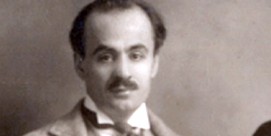In This Episode << SLIDE LEFT TO SEE ADDITIONAL SEGMENTS
AFTER THIS by Alice McDermott
On Mortality and a Marriage
by David E. Anderson
Not quite halfway into Alice McDermott’s wonderful new novel AFTER THIS (Farrar, Straus and Giroux, 2006), John Keane, abed with a slipped disk, contemplates in a mirror the reflection of a crucifix that hangs above the bed and behind his back — a wedding gift from the priest who had married Keane and his wife, Mary. He sees “the tiny gold Christ curled against the thick cross. Thick in this particular case, he knew, because behind the tortured figure on the ivory cross there was a secret compartment that contained two candles and a vial of holy water, the accoutrements of Last Rites.”
“It had not been difficult for them,” McDermott writes, “bred-in-the-bones Catholics, Irish Catholics, even at the beginning of their lives together to imagine the final scene: the candles flickering on the bedside table, the holy water glistening on his forehead, the hushed air, the dim lights, the children kneeling at this bedside, and his wife, her hand over his, assuring him, assuring him, forgiving, in the last minutes left to them, assuring and forgiving. It was a scenario he no longer deemed likely. His brother had clutched his heart and hit the pavement on Thirty-fourth Street, already gone.”

Author Alice McDermott
It is a patented McDermott moment — the writing strong and supple, the incident textured and telling, a moment of meaning and loss that even in its matter-of-factness hints at transcendence and an assurance “that pain wasn’t all, in the end. That something would trump the foolishness of body and bone, day after day.” It is the sort of moment and the kind of writing that grasps what the Church calls Ordinary Time — time ordered for the everyday living of a Christian life — and that has marked McDermott as the most distinct and interesting voice of a new generation of Catholic novelists.
“Catholic novelist,” like any label, should be used with caution. McDermott has called herself a “reluctant, resigned, occasionally exasperated but nevertheless practicing Catholic with no thought, or hope, of ever being otherwise,” and certainly her novels, especially AFTER THIS, are suffused with the materiality — the prayers and the rosaries, the incense and the gestures — of popular Catholicism in the three decades following the end of World War II.
But she is not a Catholic or Christian novelist as that term is used these days in some, especially evangelical, religious circles, where novels are marketed and categorized as “Christian” because their narrative style employs a theological Procrustean bed to ensure a “proper” uplifting ending. One is reminded of Flannery O’Connor’s criticism of such a writer, “so entranced with his Christian state that he forgets his nature as a fiction writer.” O’Connor added, “Poorly written novels — no matter how pious and edifying the behavior of their characters — are not good in themselves and are therefore not really edifying.”
At the same time, the Catholicism of McDermott’s novels represent a sharp break from her forerunners, from O’Connor, Graham Greene, and J.F. Powers. She writes without the existential “grotesque” of O’Connor, without the worldly but still religious “whiskey” priests of Greene or the corporate, spiritually empty clerics of Powers. Instead, McDermott’s Catholicism is, in part, an environment. Her characters are like fish swimming in the sea of faith, and her theme, in part, is the drying and shrinking of that milieu as it is experienced by a working-class-becoming-middle-class Irish Catholic family.
AFTER THIS begins and ends at the edge of church. Its opening words, “Leaving the church,” are immediately suggestive, and its final scene, a small, private wedding party gathered at a church door as a priest pronounces the book’s final sentence, “It’s a gift, then,” is a perfectly realized coda, a statement if not of amazing than certainly of enduring grace.
In between, the novel is, first of all, a straightforward, beautifully realized and poignant portrait of a family — John and Mary Keane and their four children. It is also a complex and compassionate meditation on change and its ineluctable costs. Finally and most movingly, it is about religious faith, its erosion and, equally important, its persistence in the face of change and loss. The story is set in the years following World War II, when the nation’s economy was rapidly expanding, transforming the working class into the newly suburbanized middle class. As the 1950s turned into the 1960s and 1970s, another war — Vietnam — and the sexual revolution seemed to overwhelm families even in their newfound prosperity.
McDermott is an acute observer with a fine eye for detail, and she renders the fabric of these middle class Irish Catholic lives with a similar but more restrained and loving verbal craft than Protestant John Updike described the small-town Pennsylvania churchgoers of his early novels and short stories. For example, as Mary and her daughter Annie stand in line waiting to see Michelangelo’s Pieta at the 1964 World’s Fair, “They shuffled forward. In the boredom and the heat there were only the tender backs of necks to consider, arches of ears, puckered elbows, freckles, birthmarks, The variety of head shapes and hair colors. What wash-day mishap or expense spared or birthday gift or Simplicity pattern had led to those clothes on that body on this day. A missed belt loop. A plastic purse. A bleached beehive. A baggy pair of Bermuda shorts. A lip held over a protruding tooth. You had to pity anyone in long pants or black socks. Women in white gloves. Soldiers in uniform. You had to pity the man behind them for the hair on his arms, the woman’s weight against him.”
McDermott’s narrative is episodic and anecdotal, covering its 30 years in a spare 279 pages. It is held together by two primary themes. The first, almost unobtrusive, is the omnipresence of war, both real and imaginary. John Keane has been wounded in World War II; his first son, Jacob, is named after a fellow soldier killed in the war and Jacob, in turn, is given up to the war in Vietnam. In between, in two significant moments of the Keane children at play, war is their make-believe. Related to the war theme is the sexual revolution, which in differing ways sweeps up and scatters Jacob’s three siblings, and McDermott has written some of the most sensitive passages in contemporary fiction on abortion and how it has been experienced in the Catholic community. “An Act of Contrition started up in her head,” McDermott writes of a young woman as she rests after undergoing the procedure at a clinic. “‘Oh my God, I am heartily sorry for having offended Thee,’ more a habit of mind than a plea for absolution. Because she could not balance any remorse against the dawning sense of relief. However terrible it might be, what she had done, it was over: gotten through, finished. However terrible it was, its immediate effect was that she could go back to school next week, her senior year.
She could take the SATs, go to the prom, go to graduation. She could sleep late tomorrow and go downstairs in her work clothes and her smock — ‘Going’ — her car keys in her hand, her father singing from another room, ‘It was a lucky April shower, it was the most convenient door,’ sweet and affectionate and naive as he always was because he had no fear of trouble for this beautiful child, no quicksand, no terrible diversions, no nightmares to drive her from the room he and his son had plumbed and paneled with their own hands.”‘
Later in the novel, on the anniversary of Roe v. Wade, a nun with polio gives a terrifying but compelling lecture to her class of young women students: “‘Girls,’ she said again, more forcefully, as if she were now girded for battle. ‘The men who make our laws see women as being as capable of murdering their unborn children as men have always been of abandoning them. They see all women as equals to Medea, should the circumstances arise. They are blind to women like my mother who put their children above all else, who labor and worry and die ‘ — she paused, her large round eyes seeming to search for the word, her two hands clutching the crutches she had placed across her lap. Her voice had not risen an octave. ‘Died tired,’ she said finally, and then raised her eyebrows as if she was surprised to discover that the word she had searched for was such a simple one.”
The second major theme, more overt, is the deeply felt but waning popular Catholic spirituality of the 1940s and 1950s — the rosary, prayers like “Angel of God,” the tradition of confession. All of these, while sustaining Mary and John, are under assault in the new America emerging in the 1950s and 1960s, and the children, each in their own way, slip away from them. Yet there are fleeting moments of remembrance. In one scene, Michael, the Keanes’ second son, recalls the Salve Regina — “Hail, Holy Queen, Mother of Mercy. Our life, our sweetness and our hope” — and realizes “how even after you’d disentangled yourself from everything else, the words stayed with you.” It is, as the writer Peter Quinn has observed, the prayer from which McDermott has taken the novel’s title: “To thee do we cry, poor banished children of Eve, to thee do we send up our sighs, mourning and weeping in this valley of tears. Turn then, most gracious advocate, thine eyes of mercy toward us, and after this our exile show unto us the blessed fruit of thy womb.” For Michael Keane these have become “words you could dismiss as a joke as readily as you could claim them as the precise definition of everything your wanted.”
McDermott captures the sense of forfeiture beautifully in several scenes centered on the decision to tear down the parish’s old church and replace it with a modern building and parochial school. John Keane sits on the parish committee charged with bringing the new building into being, and at the end of one difficult meeting, in sentences unlikely for most American novelists, McDermott writes: “Mr. Keane got into his cold car. Let the engine run a bit. The other men were pulling out of the drive and he saluted them as they drove past. They had done the work of their church.” It is a marvelous, telling incident, plunked into the midst of an American spirituality so focused on the individual that it fails to understand either the ordinariness or the corporateness of Christian discipleship.
But the new church John Keane helps bring into being is also a symbol of both the loss of the past and a changing faith in the turmoil following Vatican II — the new church with its “Bawl Room” so infants’ cries would not disturb the Mass; confessionals turned into small rooms; pews without the brass hat clips that had been on the back of the old pews: “He understood there was no longer a need for them — so few men wore hats anymore (he blamed JFK with his thick hair and his big Irish head for changing the fashion) — but the lack of them added to his own dawning sense that the new church had turned the stuff of his own past, his own memories, into something quaint, at best. At worst, obsolete.”
Two non-family members also play crucial and symbolic roles in the novel. Pauline, Mary Keane’s close friend, is a wounded and maimed soul who tries Mary’s commitment to Jesus’ admonition to “feed my lambs” and “who always saw the dashed tear, the torn seam, who remembered the cruel word, the failed gesture, who knew that none of them would get by on good intentions alone, or on the aspirations of their pretty faith.” But, as Mary realizes, “What was the cost of a little kindness toward someone who found her pleasure in being unkind? What was the good, as Sister Clare at school used to say, in loving only the lovable?” And there is Mr. Perischetti, a nurse at the state hospital for the mentally ill who calls his patients “God’s mistakes” and seems something of both the Good Samaritan and the suffering servant who has known his share of sorrow.
While brilliantly evoking the impact of war and sexual revolution on families, their community, and the Church, there seems a curious silence on one other equally important social movement of the era that had its national impact — civil rights. It may well be that the movement did not reach into the insular Catholic community of Long Island in the same way war and sex did. But one of the indelible images of the era is of nuns and priests marching in civil rights demonstrations. Perhaps the book’s silence on this topic is as truthful as any effort to manufacture an influence that wasn’t there.
McDermott deservedly won the National Book Award in 1998 for her novel CHARMING BILLY. AFTER THIS is every bit as good, and it takes her to a new level of achievement. Together, her slowly growing body of work — there are now six novels — comes together not just as one of the most insightful and accurate sociological portraits of Catholicism in the second half of the 20th century but as an eloquent, even exquisite, if one may be permitted the word, witness to the perseverance and also transformation of the faith in the lives of ordinary families.
David E. Anderson is senior editor of Religion News Service. He has written for Religion & Ethics NewsWeekly on Bob Dylan, Marilynne Robinson’s novel GILEAD, and most recently on the ethics of torture.






